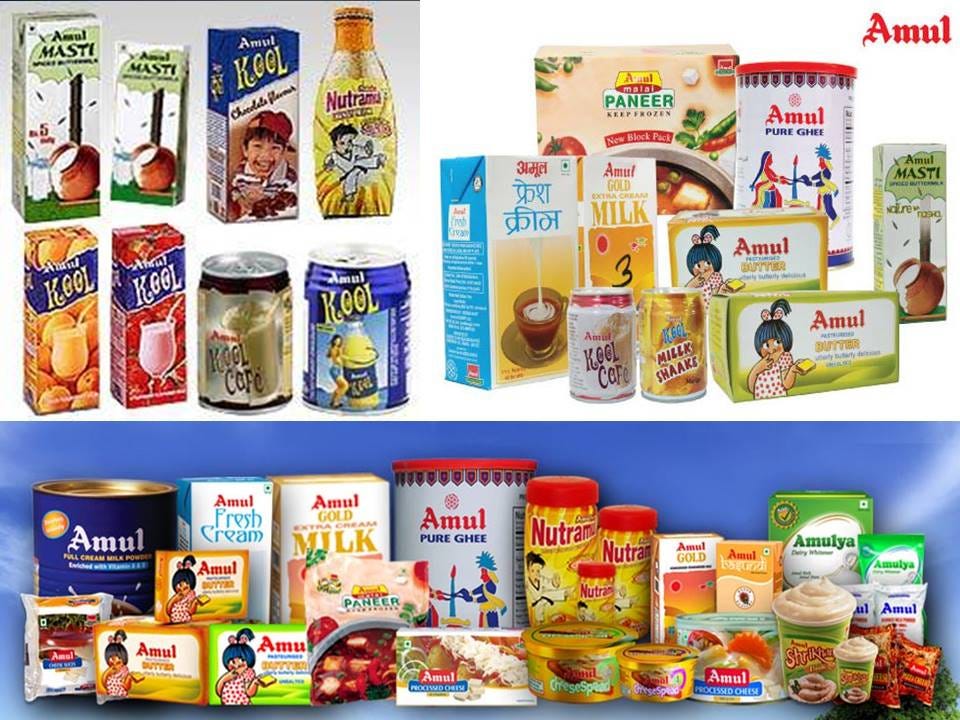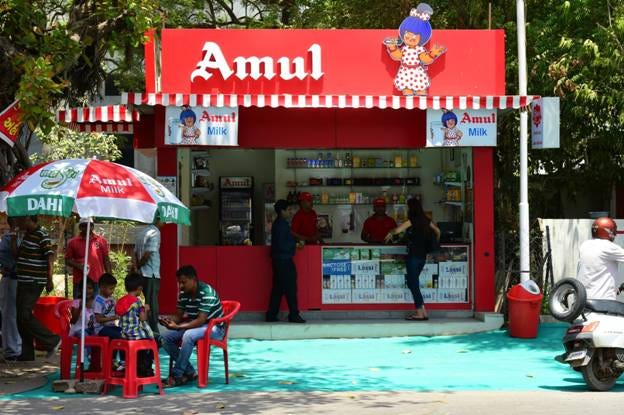How Well Do You Know Amul – One Of India’s Best-Known Brand ?
In this issue, we will try to distill some of the key elements, that make Amul one of the most successful food product companies.
Chapter 1: Background
Set up in 1973, GCMMF is India’s largest marketing organization and exporter of dairy products. It procures milk from over 36 lakh member farmers. It has 18,554 active village dairy cooperative societies and is the apex marketing federation of 18 district cooperative milk unions in Gujarat. The federation markets and distributes products of its member unions under the Amul and Sagar brands.
What does the operating model indicate?
The people who provide the raw materials i.e. milk are the members of Village dairy co-operatives
These Village dairy co-operatives are the shareholders of The District Milk Unions
The district milk unions are the shareholders of the State Milk Federation which in case of Gujarat is Gujarat Cooperative Milk Marketing Federation Ltd (GCMMF)
Thus, the raw material suppliers in turn are the ultimate owners of the state Milk Federation
Key Financial Indicators
Source: CRISIL rating rationale – 30 April 2024
Revenue grew 18% in fiscal 2023, driven by healthy volume growth and higher realizations across both milk and value-added products such as ghee, ice-cream and butter. Revenue growth remained strong, estimated at ~12% in fiscal 2024, driven by healthy volume growth and the full-year impact of price hikes taken last fiscal.
Chapter 2: The Products
The above is the broad range of products that GCMMF sells.
How does GCMMF stack up on the 5 Ps of Marketing?
All of us know the 4/5 Ps of Marketing. Let us apply these Ps and try to distill the Marketing Strategy of GCMMF
Product
Amul is known for the quality of its products. Across categories, Amul dominates the competition with its quality.
Remember – Real Milk, Real Ice Cream which led to the regulators asking non-milk-based ice creams to rename them as frozen desserts
Even non-milk products – Amul Butter cookies with NO vegetable oil, while all competition products of butter cookies have a small quantity of butter AND significant vegetable oil!
Offers choices to various segments –
Something as basic as milk – Skimmed Milk, Cow Milk, Toned Milk, Amul Gold – Rich and creamy, A2 Buffalo Milk, Slim and trim Milk, T- Special milk AND Most of them in both fresh pouches packing and long-life Milk in Tetra Pack.
2. Promotion
One common brand is Amul
Across most product categories, there is no sub-brand. The sub-brand if we can call it, is the product category – Amul Butter, Amul Ice Cream, Amul Cheese, Amul Butter cookies, Amul Pizza, Amul Cow Ghee. All Amul. The rare exception is Amul Kool which is the sub-brand for milk beverages
Amul Girl – The mascot visible across many product categories
There are advantages and disadvantages to having only one mother brand. In the case of Amul, it has taken advantage through the way the brand is promoted
Most Advertisements are across product categories – Amul the Taste of India and many products showcased in one Advertisement
NO celebrities as models/brand ambassadors in the Advertisements. This saves a lot of costs
The number of unique TV advertisements are few
Cricket is the most loved sport. Amul also sponsors cricket, but in a very novel way. Amul sponsored the South Africa team and Afghanistan teams in the one-day World Cup at a fraction of the price it might have had to spend on sponsoring the Indian team. South Africa reached the semi-finals leading to further high visibility. Even if the visibility was 50% of what it might have been with India sponsorship, it was a very high bang for the buck. It is sponsoring the same teams in the T20 World Cup also and both have reached Super 8 in different groups leading to high exposure for Brand Amul.
The T20 World Cup is in the USA and just a few weeks back Amul Milk was launched in New York. The T20 sponsorships will provide local visibility into the matches SA and Afghanistan will play. While also being viewed in India on TV, thus higher bang for the buck
Even in IPL Amul is visible as the “beverage sponsor” for some teams. This ensures very low cost of promotion, but high visibility – Every time the camera zooms to the team dugout which is almost every couple of minutes, the bottle cooler with Amul written is visible
The total spent on Advertising and promotion is less than 1% of revenues
In an interview a few years back, the then MD of GCMMF had articulated the brand strategy as “We turn to our brand strategy agencies and tell them to think lifelong while creating an advertisement” “With more than 52 years of the ‘Utterly Butterly Delicious’ campaign, the company has found its winning formula with brand marketing, Amul Doodh Peeta hai India’ has completed 15 years, ‘Amul the Taste of India’ has been in the market for 25 years, once we create, we adhere to it,” RS Sodhi said.”
Each of the above promotion strategies has one thing in common, high visibility and recall at low costs!
Packaging
The labels on every product package as we saw earlier had a distinct Amul logo prominently visible in every package.
In many products, it is distinctly yellow and green packaging with Amul Logo in Red. This standardization leads to a high brand recall.
Multiple packaging options for most products
Butter – Cardboard and Plastic tub
Ice Cream – Cup, Cone, Family packs and 1 litre tubs
Milk – Fresh pouch as well as long-life packaging
Cheese – Cardboard, Transparent plastic, plastic tubs
Amul Ghee – Plastic jars, Tin containers, Cardboard
Most plastic jars/tubs etc. are made of high quality plastic and are reused in households for a long time. Many customers buy that SKU for the long reusable packaging.
Price
Amul products are the lowest Prices in each of the categories. Irrespective of the product or the complexity of delivery or distribution or competition.
This results in very low PAT margins of less than 1%. Well as a CFO will say that Return on Sales is very low. Amul net worth is Rs 770 crore for a Rs 72000 crore revenue. Shareholders wealth is not growing. But who are the shareholders? The farmers who supply the most important raw material Milk – GCMMF ensures that the milk procurement price is remunerative to the farmers so that they continue to supply milk in large volumes.
In the entire chain from Village co-op societies to district milk unions and State milk federations, the main and only stakeholder is the farmer all the way. The farmer’s main expectation is to gets remunerated for Milk adequately and which GCMMF adheres to over all other stakeholders.
In a recent TV interview with CNBC – TV18, the MD of GCMMF was asked “Amul is India’s most successful food brand, when do we expect GCMMF to monetize this Brand goodwill in the form of IPO?” Well, every private sector company would salivate if they were in Amul’s place to launch what could be the largest IPO in India’s history. The MD’s reply was – If we go for the IPO, I must satisfy the shareholders. For that my strategy would have to be of a typical FMCG company - lower the cost of procurement and higher prices to make the margins that stock market investors would want. By doing that I would be hurting both my key stakeholders – Farmers with lower prices and customers with higher prices, and both might stop supporting me adequately in good quality high volume milk procurement or consume my products in large quantities. Why in the world should I do this? If investors want to be part of my success, let them buy my products which are both low-priced priced, of the highest quality”
Even with PAT margins of 0.15%, CRISIL has rated its debt as AAA (The highest possible rating) for many years.
Place
Amul products are sold through over 10000 distributors and over 1 million retailers.
GCMMF pays the lowest commission in each product category to distributors and retailers. Yes, this is true. I have spoken to a few retailers and validated it. Yet the product is available everywhere. And available at small corner shops, grocery stores, Medical shops, as well as organized retail chains across India
Distributors are stocking it and selling it despite low margins per unit sale. This is because while the unit margin is low, the inventory turns are high, which means with the same amount of investment, the distributors and retailers earn higher revenues by selling more Amul products as compared to the competition. This is due to the “pull” for the products, needing “negligible or no push” to sell.
Many products have relatively small shelf life and need cold storage across the value chain and despite that it has a winning combination in the entire outbound supply chain.
Amul parlors, a stop shop for all Amul products – common in Consumer durables with Samsung Plaza or LG Shoppe, but unheard and seen in Consumer goods and more importantly in Food products.
So, What Do We Understand?
GCMMF has been a contrarian on each of the elements of the Marketing strategy and that too in a highly competitive business and many multinational competitors with deep pockets and large global brands. At an estimated Rs 72000 crore revenues for 2023-24, it is bigger than HUL, ITC, Nestle, or any other well-known FMCG companies. As AMUL celebrated 50 years a few months back, a few things continue to stand out in the story:
Consistently high-quality products
Lowest prices
Low spends on Promotion – less than 1% of total revenues (This is against anywhere between 5-10% for different competition)
High Market share in most categories
An unrelenting focus on its core constituency of farmers and ensuring remunerative prices for Milk. This, in turn, leads to having a large quantity of milk procurement in the country through a well-oiled supply chain. It is this that allows Amul to scale up volumes on the various products.
Nurturing the cooperative mindset of collective well-being
Focus on cattle through scientific cattle feed and veterinarian programs for their well-being
And one brand across product categories – Amul, The Taste of India.
We look forward to your contrarian or otherwise views on Amul.
Thank you for reading The Chai and Charts Chronicles. Hopefully, your Chai was prepared with Amul Milk.
If you missed the earlier issues, you can read them here.










